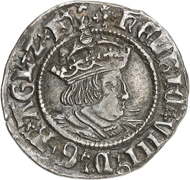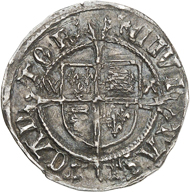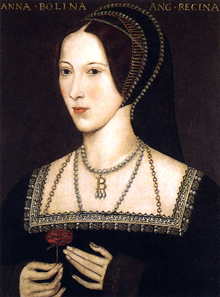courtesy of the MoneyMuseum, Zurich
translated by Teresa Teklic
Why was the human head the motif on coins for centuries, no, for millennia? And why did that change in the last 200 years? Ursula Kampmann is looking for answers to these questions in her book “Menschengesichter” (“Human faces”), from which the texts in this series are taken.
Henry VIII, King of England (1509-1547). Half-groat, archepiscopal mint in Canterbury. Crowned and armoud-clad bust of Henry, to the right. Rev. Coat of arms on long cross. © MoneyMuseum, Zurich.
Henry VIII, King of England, had a problem. Its name was Catharine of Aragón and she was his wife and mother of five royal children, only one of which (a girl, to make matters worse!) was still alive. By 1527 it was clear that Catharine would not bear any other children. Henry was faced with a decision: accept that he would never have a male heir or take a younger wife.
Portrait of Anne Boleyn. Probably a later copy of a painting from around 1534. Source: Wikicommons.
Henry didn’t struggle very hard with this decision. There was this particularly pretty court lady, Anne Boleyn … However, to bear legitimate heirs, the two needed to be lawfully wed. So, in 1527, Henry sent two delegates to the Pope to convince the highest authority of the Catholic Church to annul his marriage with Catharine. The marriage was to be annulled under the flimsy pretence of a close blood relation, which probably really did exist due to centuries of incest within Europe’s royal families, but which, to this day, had never bothered anyone. Divorces like this were part of the Pope’s daily routine. But, in this case, there was a minor difficulty. Catharine of Aragón happened to be the aunt of Charles V, whose son had just conquered Rome and taken the Pope captive. So Clement VII was not exactly free in his decision to deny Henry’s request to annul his marriage.
Henry was furious. Still, that didn’t solve the problem. The matter became only more urgent when Anne Boleyn showed unmistakeable signs of a pregnancy in early 1535. Finally, there might be another heir! Henry had to act fast if he didn’t want to risk Anne giving birth to an illegitimate child.
Henry began to cooperate with his bishops and his parliament. First, he withheld from the Pope all financial revenue from England and suspended papal jurisdiction in Church matters. This would have sufficed to clear the way for his marriage with Anne Boleyn, but Henry didn’t stop there. He proclaimed himself head of the Anglican Church and, in 1536, effected the secularisation of monasteries, which owned a not insignificant part of England’s arable land – more than 10 per cent, in fact. So, not only had Henry legalised his divorce by breaking with the Catholic Church, he had also struck a lucrative business deal.
It was truly bad luck that Anne Boleyn, just like Catharine, only bore a girl. Nobody could have foreseen at this point that little Elisabeth was to become the greatest queen of her time.
But before we turn to Elisabeth I, let’s take a small detour and visit Philip II of Spain in our next episode.
You can find all episodes in the series here.
A German edition of the book “Menschengesichter” is available in print and as ebook on the site of the Conzett Verlag.








